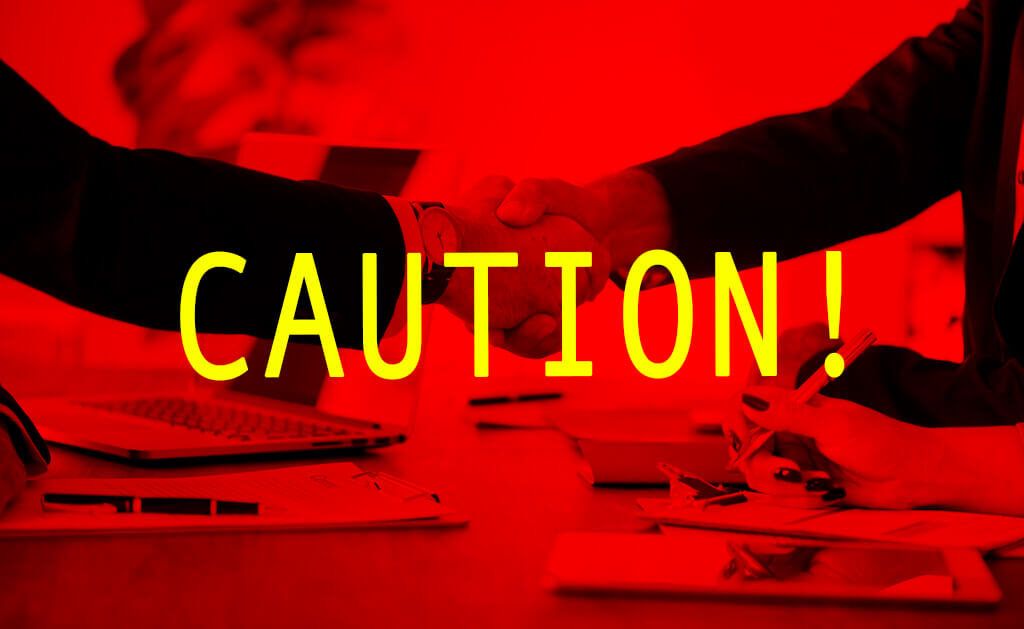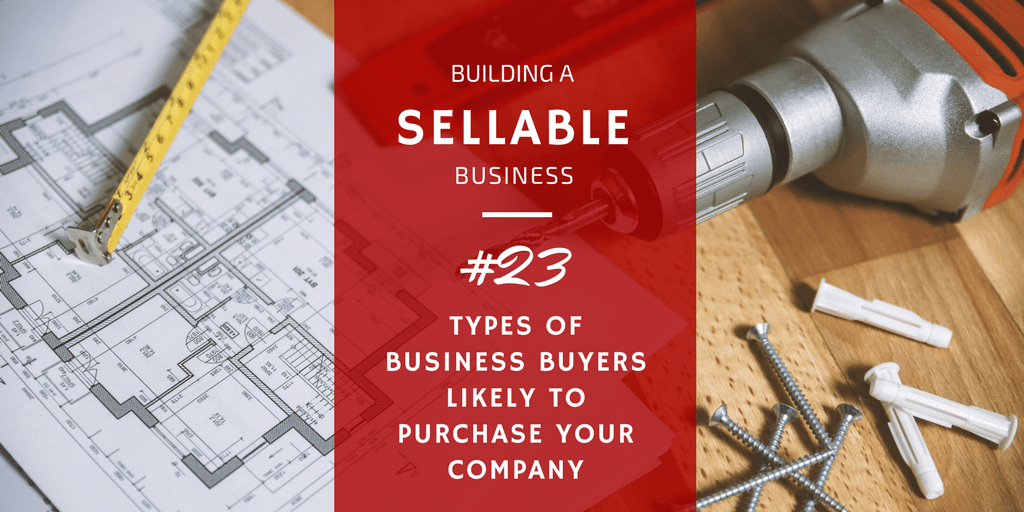
5 Pitfalls to Avoid When Researching How to Sell Your Business
March 7, 2018
The Number One Thing You Can Do to Make Your Business More Valuable
March 8, 2018Types of Business Buyers Likely to Purchase Your Company – Post #23

Most recently in this Building a Sellable Business series, we’ve been discussing the actual sale of the business. So the question I’m about to ask you might catch you off guard. Friends, who is your customer? If you’re confused, you’re defining “customer” as a person in your target sales or service market. But I’m not talking about that customer. If your goal is to sell your business, then your true customer is the person who will ultimately buy your business. That leads to the next question: “How do you identify possible candidates?”. You may be 10, 15, or 20 years from selling your company. Or, you could be looking for a buyer right now. Either way, you have to identify your true customer from the types of business buyers and then position your company to attract that investor.
Podcast Time Index for “Who is Your Customer?”
00:34 – Who is Your Customer?
00:59 – How to identify the Customer
05:30 – How do we know which Buyer to pursue?
06:02 – Types of Buyer
06:30 – Financial and Strategic Buyers
10:08 – High-Risk Takers
12:44 – Identify Buyers by Location
14:13 – Large Companies
15:19 – Summary
The Christmas Suit
On the day after Christmas last year, my mom and I went to Walmart. As we walked in the door, we came face-to-face with a clearance area. And in that area, there was this hideous suit. I can’t even tell you how ugly this suit was. It was a man’s formal dress suit with pants, blazer, shirt, and tie all in Christmas green with Christmas icons plastered all over it! Every other square inch of the fabric on the entire suit was covered in elves, Santas, presents, Christmas trees, and gingerbread men. From top to bottom, people. The pants, the blazer, the tie, the belt. I mean, it was hideous.
As I was looking at this thing kind of cock-eyed, I said to my mom, “There is NO WAY on God’s green earth I’d be caught dead in a suit that looked like that.” And Mom, being who she is, replied, “Well, different strokes for different folks.”
It Takes All Types of Business Buyers
My mom was right, you know? Life would be boring if we were all the same, right? I’m kind of glad we’re not all the same. We all have different likes and dislikes, different preferences and tastes. It takes all of us to make the world go ’round.
Similarly, business buyers come in all different shapes and sizes. Some buyers have a little bit of money while others have a lot. Frugality rules some while “spend it if you have it” rules others. Some may want an instant return on their investment while others don’t really care about getting a return. Or what about these buyers? Some look at the potential long-term capital gain from buying your business while others just want to knock out their competition.
So who are the buyers? What type of person or company buys businesses? Well, there are a couple of different categories into which buyers fall. And by going through the following exercise, you can identify your potential buyer. Once you understand who your buyer is, then you can design, shape, and create your business to appeal to that particular type of business buyer.
The Low-Risk Buyers
The first major category of buyers consists of two very different types of business customers who both desire low-risk purchases.
1. The Financial Buyer
First, we have the individuals who trade businesses like they trade stock. These people will crunch numbers to estimate their return on investment in every type of detailed scenario. Oftentimes, these buyers are looking to hold the business for less than 10 years. Thus, they’ll want to know all of the ins and outs of your business. They are NOT taking any risk that they won’t make a return on their investment within a very short time period.
Not all financial buyers are number crunchers or business traders, though. Some financial buyers come in the form of family members or employees who purchase the company. They may want to go “10 and out,” so they won’t be taking risks and gambling with their investments. They’ll look to earn a sizable living by continuing the company you began. Then, they will hope to sell it for profit when they’re ready to retire.
2. The Strategic Buyer
Now, the strategic buyer is just a slight bit different. This individual is not looking to flip a business, per say. Rather, he’s looking to buy a business which enhances his own. He may want to add a cog to his business wheel that will work in harmony with his current company. For instance, if he repairs water lines, he might want to acquire another company to dig into the earth or pavement covering the water lines. Or he may choose to merge with a company that repairs roads to fix the holes his company creates.
But not all strategic buyers want to add harmonious pieces to their existing business. Some may be your competitors, looking to take over your customer base or market niche. They want harmony; they just get it by “getting rid of” their competition.
The High-Risk Buyers
The second category of business buyers breaks into three different high-risk takers, if you will. These are the gamblers of the purchasing world.
1. The Angel Investor
Angel Investors typically work with start-up companies that show promise but have no proven track-record. Therefore, they take the most risk. These investors come in, buy part or all of the company, and help drive its success. Whenever they purchase or buy-in to a business, they usually don’t take all of the assets or buy all of the stock. However, they’ll take a majority of the interest in the company.
2. The Venture Capitalist
Venture Capitalists are not going to buy companies at ground level. Think ABC’s Shark Tank, here. These multi-millionaires will buy into a company or take ownership of a company that has a proven track record of success but needs connections that only the venture capitalist can provide. The Venture Capitalists hope that their high-level affiliations will drive the company to exponential success, making them even more money.
3. The Private Equity Firms
Private Equity firms are a bit different from the other investors because they typically only purchase the best of the best of the best companies. Consequently, they pay the most and typically deal with the largest companies worth over 100 million dollars. These firms are looking to buy the next Google or Amazon.
Location Matters to Potential Business Buyers
So we’ve categorized the types of low-risk and high-risk buyers looking to purchase businesses. Besides identifying the type of risk-taker you want to buy your particular company, you have to look at the location. What I mean is your local, regional, national, or global size can determine which types of business buyers will be attracted to your company.
Those companies that operate in a small, localized area will normally seek “mom-and-pop” purchasers. These buyers’ goal is to come in and get a return on their investment within about three to five years. They’re really not interested in spending a long time getting a company off the ground, so they seek an established business they can purchase for hundreds of thousands or a few million dollars. Then, they expect to recoup their investment in a short amount of time.
Regional purchasers will typically buy companies that operate in larger arenas that have mastered the art of scalability. These buyers will purchase companies with multiple storefronts in multiple cities or states. Because of the bigger investment and the larger marketplace, regional purchasers expect to wait about five to ten years before they see a return on their initial investment.
National and/or international buyers will purchase the publicly traded or globally based companies. These investors look for companies that are the “best of the best.” Paying more than local and regional buyers, they want everything the company has to offer. With such a large investment, these buyers will insist on solid profits from the very beginning. So they’ll look at purchasing companies that show reliable trends and steady customers.
The Buyer is Your Ultimate Customer
I give you this article today to help you identify the types of business buyers most likely to purchase based on risk and location. If you can determine the specific buyer for your company, you have an idea of which direction to grow the company during the start-up or growth phase. If you’re ready to sell, identifying your buyer will help clarify where and how to reach an investor… one that will agree to your asking price, the topic of our next article.
Then here we are. As I always say, life is hard. Life is complicated. This is getting kind of fun if you think about it. Let’s just remember to keep our lives, at least, financially simple.




